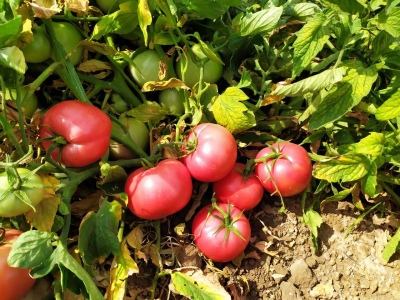
- Authors: Gladkov D.S.
- Year of approval: 2015
- Name synonyms: Werner F1
- Category: hybrid
- Growth type: determinant
- Appointment: fresh consumption
- Ripening period: mid-early
- Ripening time, days: up to 105
- Growing conditions: for open ground, for film greenhouses
- Bush size: undersized
Choosing the right tomato variety for many people seems to be a very difficult task. However, it is simplified if we restrict ourselves to the most recent developments in this area. And not the least among them is Werner's tomato.
Breeding history
This culture was created by a fairly well-known breeder D.S.Gladkov. It was officially approved for use in vegetable gardens in 2015. It is curious that a number of sources write about the creation of this plant in Holland.
Description of the variety
Werner is one of the hybrid tomatoes. It is characterized by:
determinant growth;
height no more than 0.7 m;
the power of the bushes;
medium size of dark green foliage;
optimal early maturity;
low level of foliage.
The main qualities of the fruit
Still unripe berries can be confidently identified by their light green color. As it develops, Werner's fruits turn pink. It is stated that their mass can range from 208 to 245 g. A rounded tomato contains moderately firm flesh. The berries look attractive.
Taste characteristics
The fruit tasting ratings are very high. As a result of the examination, the professional commission gave 9 points out of 10. There is simply no acidity typical for many tomatoes. But there is a pleasant sugar content. The general conclusion is that the crop can be safely consumed both fresh and in the form of:
salads;
juices;
ketchup;
tomato paste.
Ripening and fruiting
Werner is a simple medium early tomato. Under normal conditions, berries are ready for picking within 105 days. The countdown begins as soon as the plant throws out green growth. In some years, the actual weather makes strong corrections. Fruits are harvested in:
July;
August;
September;
October.
Yield
The ability to achieve very high yields is claimed. They can be up to 14.2 kg per 1 sq. m. It should be understood that we are talking about the result of cultivation with strict adherence to agrotechnical standards. However, even with this amendment, Werner remains an excellent culture.
The timing of planting seedlings and planting in the ground
You need to prepare containers for seedlings by March. It gains the necessary conditions for transplanting to open areas in 60 days of development. As always, take into account the actual and forecast weather.

Growing tomato seedlings is an extremely important process, because it largely depends on whether the gardener will be able to harvest at all. All aspects must be taken into account, from seedbed preparation to planting in the ground.
Landing scheme
The gap between the bushes should be 0.5 m. The typical row spacing is 1 m. A number of sources write that it can be reduced to 0.7 m.

Growing and care
Fruit cracking is uncommon for Werner. Seedlings should be kept in diffused sunlight.Direct sunlight can be detrimental to her. A pick of young seedlings is carried out 14 days after the formation of shoots. Seedlings in peat pots should be deepened by about 5 cm.
When planting in open ground, a tomato should be disinfected with copper oxychloride. Abundant watering of seedlings is possible only after the formation of the very first leaves. This watering is continued for a week after transplanting into open ground. And also planting will need to be protected from the sun, wind and possible frost; after the end of the critical period, the care is the same as for other tomatoes.




A plant needs different micronutrients at each stage of growth. All fertilizers can be divided into two groups: mineral and organic. Folk remedies are often used: iodine, yeast, bird droppings, eggshells.
It is important to observe the rate and period of feeding. This also applies to folk remedies and organic fertilizers.
Disease and pest resistance
The variety tolerates the main tomato diseases well. Pests specific to it are not described. Prevention measures will be minimal.


Resistant to adverse weather conditions
This tomato must be protected from bad weather at an early stage of development. The shelter should also provide protection from excessively bright sun. It is necessary to remove the shelters only after the final rooting.
Growing regions
Fruiting will be successful even in the northern regions of the Russian Federation. But there the culture must be cultivated in greenhouses. Cultivation in the southern regions, at a summer temperature of +18 to +25 degrees, is possible in the open air.

























































































